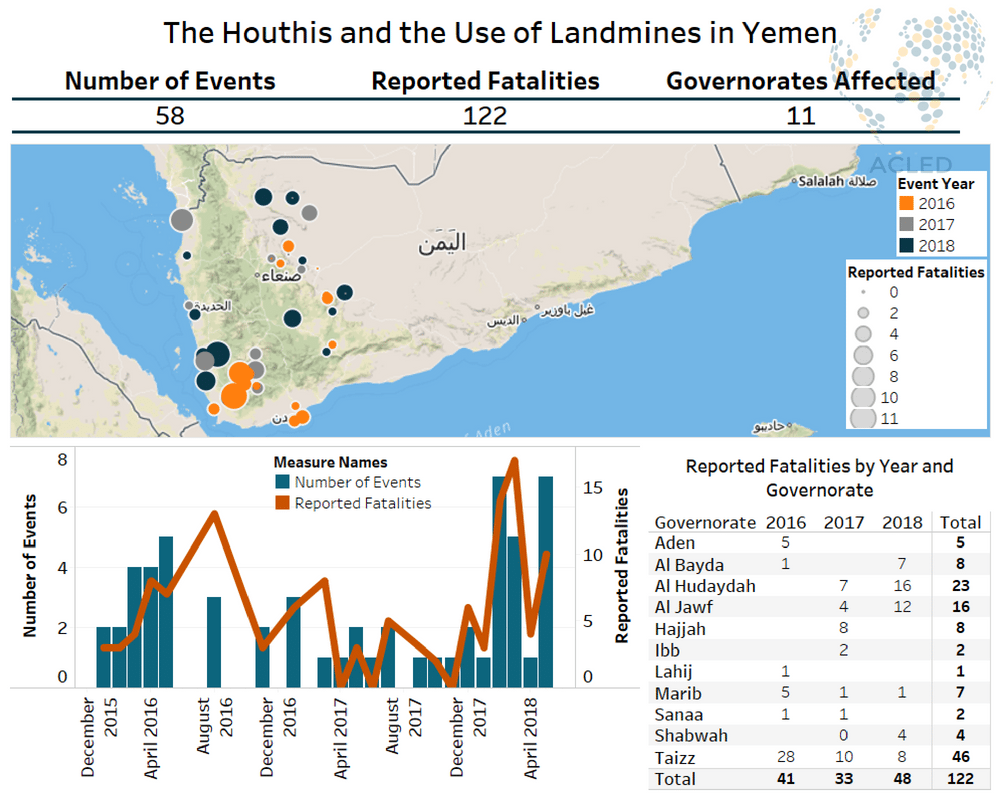Although air strikes by the Saudi-led coalition continue to account for the highest number of reported civilian fatalities, Houthi-planted landmines are a persistent threat for Yemeni civilians. On May 22, three unarmed citizens were reportedly killed when they stepped on an explosive device planted by the Houthis near the military port of Al Haymah, in Hodeidah (Al Masdar, 22 May 2018). A few days earlier, a vehicle with three people on board hit a landmine in the northern Al Jawf governorate, reportedly killing them all (Al Masdar, 13 May 2018).
These are the latest episodes of a longer series of violent events involving civilians in Yemen. According to recently released ACLED data, landmines and other improvised explosive devices (IEDs) planted by the Houthis have killed an estimated 122 civilians and wounded several others in 58 single incidents recorded since 2016. The highest number of civilian fatalities is reported in the governorate of Taizz with a total of 46 unarmed civilians reportedly killed since January 2016, followed by Hodeidah and Al Jawf with 23 and 16 reported fatalities respectively.
Due to the difficulty of obtaining accurate estimates, these figures are likely to make up a fraction of all mine detonations involving civilians in Yemen. According to the Landmine Monitor initiative, landmines and other explosive remnants of war (such as unexploded cluster bombs or grenades) caused 2,104 casualties in 2016 countrywide, more than twice than in the previous year (Landmine Monitor Initiative, 13 July 2017). Yemen’s Minister of Human Rights indicated that Houthi-planted landmines may have killed up to 440 people and injured more than 540 others since 2016 (Gulf News, 2 May 2018). Regardless of the exact numbers, clearing operations conducted in territories recently liberated by the Houthis confirm the magnitude of the threat, having defused approximately 300,000 randomly planted explosive devices. Yemeni military sources claim that Yemen has been the site of the “largest mine-laying operation since the end of the Second World War.” (Arab News, 28 May 2018).
Houthi forces, in conjunction with their formerly allied Saleh loyalists, are reported to have laid anti-personnel and anti-vehicle landmines since the outset of the war. The London-based Conflict Armament Research Center showed that the Houthis have often concealed explosive devices to resemble rocks, a tactic used by Hezbollah in Lebanon and other armed groups in Iraq and Bahrain (Conflict Armament Research, March 2018). Several neighbourhoods in Aden were heavily mined as Houthi-Saleh began to withdraw from the southern port city (Human Rights Watch, 20 April 2017). Yemeni soldiers have defused approximately 40,000 landmines across Marib governorate and 16,000 only on the island of Perim in the Bab al Mandab Strait (Asharq al Awsat, 5 May 2018). In Hodeidah, the Houthis have also planted thousands of mines across the governorate, including in the regional capital and in the UNESCO World Heritage site town of Zabid.
The large-scale use of IEDs across the country has major implications for the ongoing offensive in Hodeidah as well as for Yemen in general. Explosive devices, often planted indiscriminately, have already inflicted losses to the advancing troops and can slow down their push towards the port city despite the reported use of mine-resistant vehicles (The National, 2 June 2018; Washington Institute for Near East Policy, 15 May 2018). The alleged presence of landmines near the port, the airport, and other key sites in Hodeidah may deter the Saudi-led coalition from launching an all-out assault, which would likely result in destroying the city, displacing hundreds of thousands of people, and precipitating the humanitarian crisis (All Party Parliamentary Group for Yemen, 22 May 2018). However, landmines are also going to have a lasting impact on the Yemeni population: many Yemenis fear to return home because of the landmines randomly planted near their homes while defusing all explosive devices laid in Yemen during the war will take years.
Find an explanation of ACLED’s methodology for monitoring the conflict in Yemen here.







